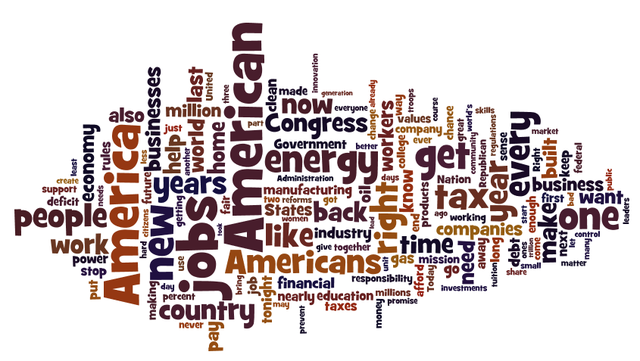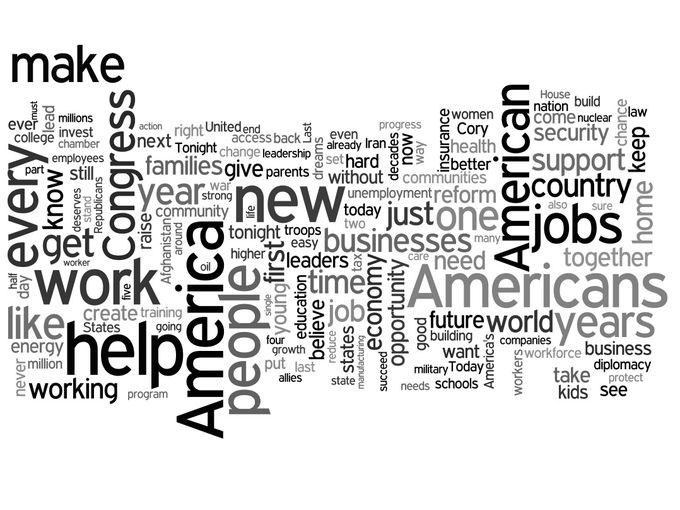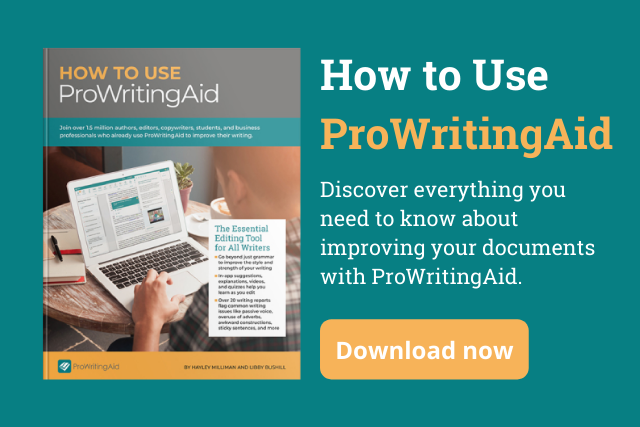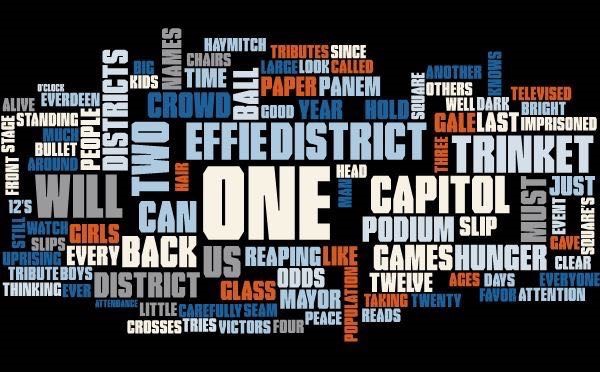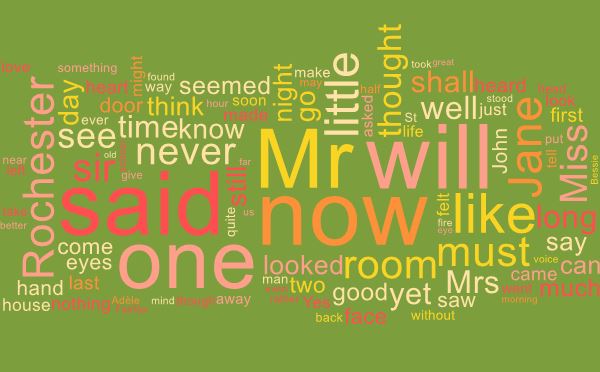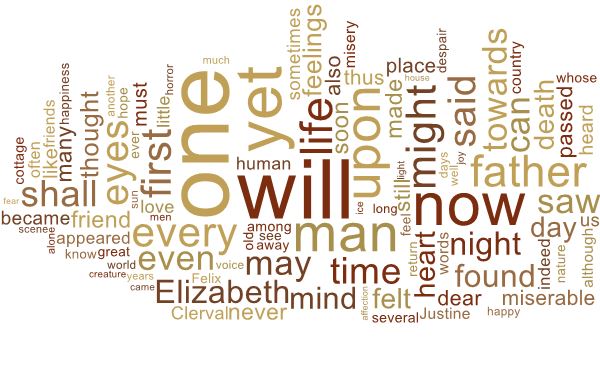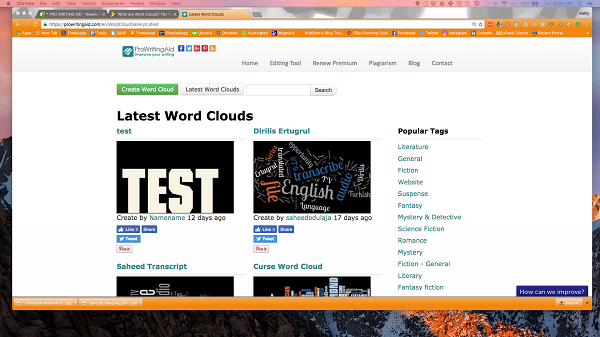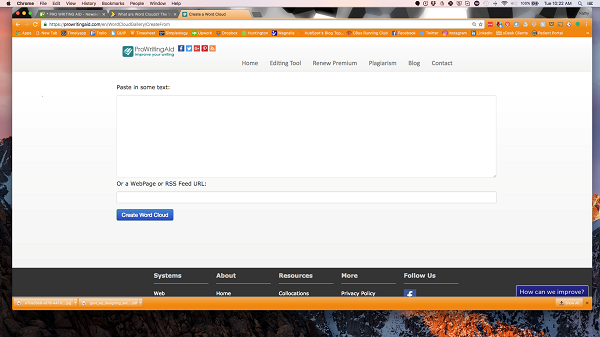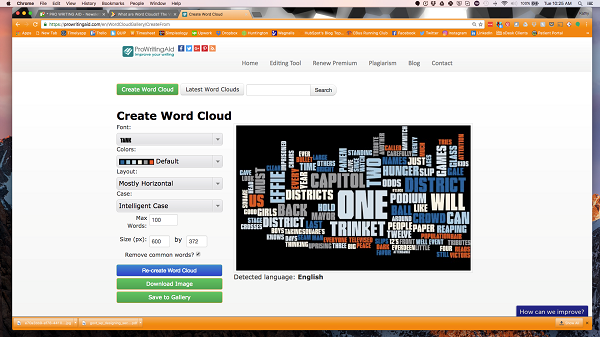Data visualizations (like charts, graphs, infographics, and more) give businesses a valuable way to communicate important information at a glance, but what if your raw data is text-based? If you want a stunning visualization format to highlight important textual data points, using a word cloud can make dull data sizzle and immediately convey crucial information.
When you’re looking at an in-depth data analysis, do you find it difficult to discern which points are the most important?
Anyone who’s ever stared blankly at a lengthy database or long pages of text can relate. With so many insights to comprehend, how do you know where to begin?
Word cloud generators can help simplify this process.
If you’ve ever looked at a jumble of disparate words that seem to have no correlation until you investigate further, you’ve seen a word cloud. These are powerful tools across myriad industries, from art to science.
Today, we’re exploring their use in the field of data visualization. Along the way, we’ll share how your organization can use them to help pinpoint important issues and better direct your steps forward.
Ready to learn more? Let’s get started!
What are Word Clouds?
Word clouds (also known as text clouds or tag clouds) work in a simple way: the more a specific word appears in a source of textual data (such as a speech, blog post, or database), the bigger and bolder it appears in the word cloud.
A word cloud is a collection, or cluster, of words depicted in different sizes. The bigger and bolder the word appears, the more often it’s mentioned within a given text and the more important it is.
Also known as tag clouds or text clouds, these are ideal ways to pull out the most pertinent parts of textual data, from blog posts to databases. They can also help business users compare and contrast two different pieces of text to find the wording similarities between the two.
Perhaps you’re already leveraging advanced data visualization techniques to turn your important analytics into charts, graphs, and infographics. This is an excellent first step, as our brains prefer visual information over any other format.
Yet, what do you do if your raw data is text-based in nature?
Much of the research your organization conducts will include at least some form of an open-ended inquiry that prompts respondents to give a textual answer.
For instance, you might ask current customers what they like or don’t like about your new product line. Or, you could ask them to give suggestions on how your organization could improve. They could also have the chance to elaborate on any pain points they’re experiencing.
There are industry tools that allow you to code such open-ended data so users can understand it quantitatively. Yet, these don’t come cheap. Word clouds offer a cost-effective, yet powerful, alternative.
With these, you can still quantify your text-based insights into measurable analytics. The only difference? You won’t create a chart or graph as you would with a set of numbers.
Instead, you’ll create a word cloud generator to transform the most critical information into a word cloud.
Here’s an example from USA Today using U.S. President Barack Obama’s State of the Union Speech 2012:
As you can see, words like “American,” “jobs,” “energy” and “every” stand out since they were used more frequently in the original text.
Now, compare that to the 2014 State of the Union address:
You can easily see the similarities and differences between the two speeches at a glance. “America” and “Americans” are still major words, but “help,” “work,” and “new” are more prominent than in 2012.
Using word clouds isn’t exclusively for creating presidential eye candy. Keep reading to discover how word clouds can benefit your business.
Where Word Clouds Excel for Businesses
In the right setting, word cloud visualizations are a powerful tool. Here are a few instances when word clouds excel:
- Finding customer pain points — and opportunities to connect. Do you collect feedback from your customers? (You should!) Analyzing your customer feedback can allow you to see what your customers like most about your business and what they like least. Pain points (such as “wait time,” “price,” or “convenience”) are very easy to identify with text clouds.
- Understanding how your employees feel about your company. Text cloud visualization can turn employee feedback from a pile of information you’ll read through later to an immediately valuable company feedback that positively drives company culture.
- Identifying new SEO terms to target. In addition to normal keyword research techniques, using a word cloud may make you aware of potential keywords to target that your site content already uses.
When Word Clouds Don’t Work
As mentioned, word clouds aren’t perfect for every situation. You wouldn’t use a pie chart to show company revenue growth over time, and you shouldn’t use word clouds for every application, either. Here’s when you want to avoid using a word cloud.
- When your data isn’t optimized for context. Simply dumping text into a word cloud generator isn’t going to give you the deep insights you want. Instead, an optimized data set (one handled by an experienced data analysis team) will give you accurate insights.
- When another visualization method would work better. It’s easy to think “Word Clouds are neat!” and overuse them — even when a different visualization should be used instead. You need to make sure you understand the right use case for a word cloud visualization.
There are many other instances when a different visualization should be used over word clouds. (Feel free to contact one of our data analysts to learn more.) More complex data sets and projects require a team of developers and designers for a complete transformation. In could an infographic or dashboard, but word cloud applications are limited to, well, words.
What is a Word Cloud Generator?
As its name implies, an online word cloud generator is a tool that scans a body of text, turning it into component words.
From there, it can create a word cloud that highlights the most frequently mentioned words. If you don’t prefer the cluster shape, most tools enable you to format the word cloud in various ways, including:
- Horizontal lines
- Columns
- Formed to fit a certain shape
Most providers will also allow users to choose different layouts, fonts and color schemes depending on their preference. This means you can make one to match the color scheme of your brand, your partners, or your clients.
While the color used on a word cloud holds a primarily aesthetic value, you can contrast the hues to help categorize words or illustrate a separate data variable.
Why Use a Word Cloud Generator?
Think word clouds aren’t relevant to your organization? Think again.
These are an unexpected yet powerful way to display important data visualizations. Let’s take a look at a few of the top ones.
1. Understanding Client Issues
How are you currently analyzing your customer satisfaction levels? From polls and surveys to social media posts and more, your audience is talking about your brand.
As they do so, they’re delivering valuable insights into the psyche of your target customer. What’s making them tick and what to do they love? Are there any issues that seem to pop up time and again?
It can be difficult to find the answers to these questions if you’re simply reading each comment on an individual basis. Yet, when you create a word cloud with this feedback, you can quickly visualize what everyone is talking about.
For instance, you might notice that phrases such as “wait time” or “attitude” appear to dominate the cloud. This can reveal your customers’ pain points.
Or, you might see positive terms such as “affordable” and “customer service” towering over others, revealing what you’re doing right. Either way, you’ll know which topics to focus on at your next meeting, and you’re already one step in the direction of change.
2. Quickening Business Actions
That important marketing research report just came in at 5:00 p.m. The only problem? It’s 50 pages long.
You’d love to read through it line by line, but you don’t have enough hours in the day, and you’re supposed to give a brief on the data the next morning. This is where a word cloud generator can help.
When you copy the text into the generator and let it do its job, you can see in seconds which talking points appear the most frequently. Then, you’ll know where to start your search to hit the most important parts.
3. Analyzing Employee Sentiment
When you ask employees to share their feedback and opinions about the workplace, what do you do with those responses? It can be difficult to turn this kind of unstructured data into meaningful action if you don’t know where to start.
This is where word cloud visualizations can help.
When you’re able to see which points your employees are discussing at the highest rate, you’ll know how to make valuable and meaningful changes that can boost morale, strengthen company culture, and improve performance.
4. Simplifying Technical Data
You could present highly technical researching findings to a non-technical audience, such as your community board of directors. Yet, when you do so, it’s common to look into an audience of blank stares.
When you present a word cloud instead, you’re able to share the same findings in a more accessible and engaging way. This expands your reach and enables you to share important information in a way that doesn’t require advanced technical understanding.
5. Searching for Patterns in Data
With quantitative data, charts, graphs, and other data visualizations can help you identify key patterns. However, pulling these same insights from qualitative data can prove cumbersome at best and impossible at worst.
A word cloud generator makes this process a cinch. Those words you see overpowering the others? Those are your salient points and overlapping themes.
These would be difficult to find in a tabular format, but they pop out in a word cloud.
6. Search Engine Optimization
You have a good basic grasp on the kinds of keywords that your target audience wants to see. In fact, you might even use a keyword generator to find the most popular ones in your industry niche.
However, do you really know how Google sees your website?
The answer to this question can make or break your Search Engine Optimization (SEO) strategy.
You can use a word cloud generator to see how your content appears to Google bots and similar machines. While it won’t reveal the more technical elements of SEO such as headers, backlinks, and alt tags, it does help you see the general message that your page conveys.
This is important because when Google “looks” at your page, it does so by scanning its content and code. You might think you’re getting the right points across, but do they really dominate? Your word cloud can reveal if you’re giving enough attention to the keywords that matter.
How to Make a Word Cloud
As shown by their increasing popularity, making a word cloud for your website or business isn’t difficult, but there are some important considerations that need to be made so your visualization is more than just eye-candy. While word clouds can be incredible tools for data visualization, it’s important to understand how to use them the right way.
Step 1: Optimize Your Data Set
First, you’ll want to get a valuable, text-based data set. Make sure the data set you’re using is both text-based and optimized for context. Copying and pasting just any textual data into a word cloud generator might not give you the exact insights you need.
Not sure where to begin?
Our team of data analysts is skilled in taking unstructured text and turning it into an optimized data set. First, we’ll help you make sure the source data you’re referencing is both usable and actionable. Then, we’ll compile it in a way that draws out the most interesting and relevant content. Having an experienced analyst compile this helps to ensure your source data is actually usable.
Step 2: Use a Word Cloud Generator Tool
Once your data set is in place, your next step is to run it through a word cloud generator tool. Many businesses like and use Wordle, but there are many others you can try, too (such as Tagxedo and WordItOut). The downside to these free tools is many sites, including Wordle, automatically add all text clouds to their portfolio. This means any site visitor can see it, potentially undermining your marketing efforts. (Check your individual tool’s policies to see if your word cloud will be used in this way.)There are many online resources and apps you can use to perform this step, including:
- Wordle
- Tagxedo
- Tag Crowd
- WordItOut
- Word Cloud Generator for Chrome
- Word Cloud Python tools
- Google Word Cloud tools
Step 3: Export the Word Cloud
Once you create your word cloud, you need to move it from the program to your files. Some platforms will enable you to download the image as a PDF, although many won’t make that easy. In some cases, you’ll have to take a screenshot of the image and save it that way.
Before you close out of the program and start reviewing the data, there’s one security precaution to keep in mind.
While most of the programs above are either free or low-priced, keep in mind that there can be some drawbacks to the convenience they offer. For instance, any time you create a word cloud in Wordle, it saves it to its virtual portfolio.
This might not be a deal-breaker if the data you’re compiling and analyzing isn’t confidential or highly sensitive. Yet, if you work in an industry (such as healthcare or banking) that emphasizes confidentiality and customer data protection, this can render the service unusable.
It’s also a drawback if you’re using a word cloud for marketing purposes. If anyone can search Wordle’s portfolio, there’s nothing stopping them from tapping into your most compelling data.
An easier, safer and all-around better route to take? Create your word cloud from scratch rather than relying on an online program to do the work for you.
Exporting your word cloud from a free tool might take some work. Sometimes, if download as an image or PDF isn’t available, you’ll be forced to take a screenshot – a less-than-elegant solution.
Here’s what to do if you really want your word cloud to be noticed: consider designing your word cloud from scratch!
Does this sound like a lot for you to handle in-house? Not all companies have (or need) an in-house data analyst. Our experienced team at Boost Labs has experience working with enterprise clients such as the U.S. Census Bureau, small businesses like individual websites, and everything in-between.
Creating Your Own Word Cloud
Sure, it’s simple to plug your text into a virtual generator and receive your custom word cloud in seconds. Yet, as we’ve discussed, this can put your most critical data sets in a vulnerable position.
Instead, why not let our team take the reins and create a one-of-a-kind word cloud that’s all yours? This eliminates the risk of your information falling into the wrong hands.
A data visualization expert can also help you pinpoint the most cloud-worthy parts of your unstructured data set so you’re not sifting through tomes of irrelevant data, attempting to make disjointed parts connect.
We’ll work with the most insight-rich parts and deliver a personalized graphic that you can use in your short-term and long-term department planning efforts.
The Best Word Cloud Generators Are Custom
Around the world, we’re creating and sharing more data than ever before and the trend shows no sign of stopping down.
From sales numbers to online traffic rates, you’ve likely got plenty of quantitative data to analyze and discuss. Yet, are you making as much use out of your qualitative inputs?
These are often some of the most insightful data points your organization can leverage. They’re full of opinion, long-form feedback, and personal reflection. Word cloud generators can help make the most of this content, one visual at a time.
Are you ready to discover the power of word clouds for yourself? We’d love to help.
We’re data visualization experts, dedicated to helping companies turn mind-numbing data into interactive and informative graphics, charts, tables and more. Contact us today and let’s discover something new together.
Let us help you with data visualization.
If you haven’t tried ProWritingAid’s Word Cloud Gallery, get ready to have your mind blown.
Looking to learn more about how ProWritingAid works? Our new eBook gives you all the information you need to start editing like a pro with ProWritingAid.
Download to learn how to customize your settings, use each of our 20+ in-depth reports, install our many integrations, and how you can get the most out of your ProWritingAid subscription.
What is a Word Cloud?
Google says a word cloud is “an image composed of words used in a particular text or subject, in which the size of each word indicates its frequency or importance.”
So, the more often a specific word appears in your text, the bigger and bolder it appears in your word cloud.
ProWritingAid has a Word Cloud Gallery that makes it easy to create word clouds based on the text you paste into the tool. Here’s what a word cloud based on the reaping scene in the first chapter of The Hunger Games looks like:
Below are a couple other word clouds. Can you recognise the novels from their word clouds?
Or, if you are up for a challenge, try our Word Cloud Game. Guess 10 classic novels from the word clouds that they generate.
Word Clouds For Fiction Writers
Every writer has words they like to use over and over. When we edit our own words, it’s hard to see what our overused words are. But when we use them too often, our writing sounds redundant. A word cloud can help you identify your overused words. The most commonly used words are the biggest. It’s easy to see if the big words are the words you want to use the most.
Do you have too many dialogue tags? If so, «said» will show up as a larger word. You can then go find places in your writing to add action or emotion beats. Do your characters smirk or shrug all the time? A word cloud can help you find the actions you repeat too often.
A word cloud can also make sure you are focusing on the right characters, themes, and plot points. If your book is about Jane, but Jack’s name is three times bigger, you might need to re-evaluate your manuscript. If your book is about a war, but the words «war» and «battle» are tiny on your word cloud, you’ll need to develop that plot more.
Word Clouds For Copywriters And Bloggers
Search engine optimization. It can be the bane of copywriters and bloggers everywhere. The algorithms are always changing. But it doesn’t have to be a mystery. The most important part of SEO is keywords.
Run your copy or blog post through a word cloud generator. Are your target keywords huge or tiny? What words have you inadvertently turned into SEO keywords? This will help you figure out exactly what edits you need to make to reach those high search engine rankings.
When To Use Word Clouds
For fiction, you can use word clouds of different scenes to compare how your characters feel about the inciting action. A word cloud will help you notice right away if your characters’ reactions are similar in both scenes. You’ll be able to identify where you should have a new reaction or a new emotion.
For business purposes, word clouds can help you find your customers’ pain points. If you collect feedback from your customers, you can generate a word cloud using customers’ language to help identify what is most important to them. Imagine if “long wait time” cropped up as major emphasis words in customer feedback. That should ring a warning bell.
If you are in the business-to-consumer writing industry, a word cloud will highlight overuse of technical jargon. You can make sure your language is accessible to consumers with a quick visual model.
When Not To Use Word Clouds
Simply dumping a scene from your current work in progress into a word cloud generator might show you that you used “said” a lot, but won’t give you the insights you want. But using word clouds to compare your scenes against each other can show you where they’re too similar, use too many of the same unimportant word choices, or simply aren’t consistent between scenes when they need to be.
Likewise, in copywriting for business, you wouldn’t use a word cloud when your content isn’t optimized for keywords. A word cloud on a blog post that’s not SEO enhanced won’t tell you much about your keyword density.
No matter what you’re writing, word clouds are something to use as a last step in your writing process. Word choice falls under «line edits.» If you have an unedited first draft, word clouds won’t help you much. You’ll likely need to make major structural changes before you use a word cloud.
How ProWritingAid’s Word Cloud Gallery Works
At the bottom of every page on ProWritingAid.com is a link under “Resources” called Word Cloud Gallery. When you click on that link, you get something that looks like this:
Notice at the top, you have options to “Create a Word Cloud” or search for the “Latest Word Clouds” by keyword. A sidebar on the right side contains popular tags to help you narrow your focus on already-generated word clouds.
When you click on “Create Word Cloud,” it brings up the following screen:
Simply copy and paste your text into the box or enter your url, and click on “Create Word Cloud.”
Here’s what your new word cloud looks like:
Notice you have an interesting graphical representation of the words in your text, which you can customize by choosing a font, color, and layout. You can also re-create the word cloud with new text, download the image to your computer, or save it to the ProWritingAid gallery so that others can see and use your word cloud.
Final Thoughts
Word clouds are fun to use as a visual aid with blog posts to underscore the keywords on which you’re focusing. Your readers will notice the larger, bold words and understand their importance to your post.
And for fiction writers, word clouds are great to make sure you’re focusing on the right words in your prose. It’s also interesting to see some of the word clouds in the ProWritingAid gallery that other writers have created, especially those in the genre-specific popular tags in the sidebar on the right.
Play our Word Cloud Game here.
How do you see word clouds helping your writing? Let us know if you’re a fiction writer or copywriter and how you might use a word cloud.
Or if you’ve already created a word cloud on ProWritingAid.com, let us know what insights you gained from it.
In the meantime, happy writing!
Find everything you need to know about using ProWritingAid in our Ultimate Guide. Download the free eBook now:
How to Use ProWritingAid
Join over 1.5 million authors, editors, copywriters, students and business professionals who already use ProWritingAid to improve their writing.

In addition to the classic graphics, there are other resources that facilitate the visualization of data, such as the word cloud. When well used, this tool can make all the difference in the quality of scientific work.
It is a visual resource composed of loose words about a certain subject. This tool is constantly used in science to highlight the most mentioned words in a text .
Regardless of the system used to generate the cloud, the methodology is the same: each word has its size and color intensity determined by relevance in a corpus.
The higher the frequency of a given term, the greater its prominence in the image. A word cited 60 times in the content, for example, appears more than one cited only 30 times.
In the academic area, it is often used to identify the subjective aspects of a survey, especially those that are constructed from interviews with open questions. In addition, there are many other uses for and tool.
When to use?
In text analysis
These can be used in different situations. They serve as an instrument for text analysis and also for highlighting the most important topics.
The technique is still considered useful for comparison purposes. It serves to analyze works and seek similarities between them.
Data interpretation
Creating a word cloud can also be linked to a quiz question . Thus, the terms most mentioned by respondents appear larger, indicating greater relevance to the detriment of others.
It is a useful tool in content analysis , especially when it comes to qualitative data. It provides a view that the graph is not able to show.
in the resume
Some researchers use the word cloud feature to spice up the resume. In this case, the objective is to gather the words that appear most frequently in the titles of published works.
In the didactic
Teachers use the word cloud with students in order to understand the thoughts of the class. This didactic method defends the idea of simultaneous collaboration, that is, several people participate in the construction of the cloud in real time.
in the brainstorm
Suppose you are developing a group project . Each person has their own repertoire, therefore, they know a certain subject in a way. In this context, the word cloud helps to understand what is on the mind of each team member and from there to continue the project.
The word cloud, generated in the brainstorm , signals perceptions, values, trends and goals.
Academic papers that use word cloud
We have selected some academic productions that use the this technique.
- Content analysis through word cloud of posts in virtual communities: new perspectives and preliminary results
- A scenario of Statistical Education in Pedagogy courses
- Use of virtual communities to support breast cancer patients
- Application of text mining in the analysis of textual productions
How to make a word cloud
It can be done manually, but this is not the easiest way to use the feature. The recommendation is to use digital tools that identify the most frequent words in content and generate the cloud automatically.
Here are some ways to build word clouds:
Google Docs
Creating a word cloud is an easy task when you have Google Docs. The online text editor generates the set of terms from the analysis of a document in .doc format. For that, however, you must install an add-on called Word Cloud Generator.
After installation, click Add-ons, choose Word Cloud Generator and set your word cloud font style – it can be classic or modern. Then click the download button to download the cloud image.
wordclouds
Wordclouds is a free word cloud generator widely used in academic work to enrich the presentation of data.
Using the tool is very simple:
- Click on File ;
- Request the creation of a new cloud in New Word Cloud ;
- Click on Word List and choose the way you want to insert the text that will be analyzed. The program imports internet links, PDF documents, among others;
- After generating the cloud, make the necessary changes and use the shortcut Ctrl + S to save. It is possible to save the created clouds in PNG, PDF and SVG.
WordArt
Another free online application that generates word clouds that can be customized. The great advantage of the platform is that it allows you to enter data manually or import the words listed into a spreadsheet.
- Click Import and select the content you want to analyze. You can also write the words manually by clicking on +Add ;
- Hit the red Visualize button to generate the cloud.
- If you don’t like the automatically generated slideshow, use the left corner window to change colors, font and layout.
- After finishing editing, click Download and choose the file format to download to the cloud.
liemeter
Mentimeter is an application for creating presentations with real-time feedback. If you want to brainstorm a word cloud, this is the best option as it allows for simultaneous collaboration.
- Create a New Slide;
- Choose the Word Cloud option ;
- Enter a question.
- Share the link with participants.
- As responses are recorded, the cloud content is updated in real time.
R language
Professional statisticians use other tools to generate word clouds, as is the case with the R language. It was developed to use statistical data analysis techniques.
R has a set of tools for manipulating data, doing calculations and creating graphs.
Asked by: Mr. Keyon Baumbach
Score: 4.2/5
(54 votes)
A tag cloud is a novelty visual representation of text data, typically used to depict keyword metadata on websites, or to visualize free form text. Tags are usually single words, and the importance of each tag is shown with font size or color.
What is word cloud used for?
Word Clouds are visual displays of text data – simple text analysis. Word Clouds display the most prominent or frequent words in a body of text (such as a State of the Union Address). Typically, a Word Cloud will ignore the most common words in the language (“a”, “an”, “the” etc).
What is example of word cloud?
For example, “apples~and~oranges” would appear as “apples and oranges” in the word cloud.
How would you describe a word cloud?
Google says a word cloud is “an image composed of words used in a particular text or subject, in which the size of each word indicates its frequency or importance.” So, the more often a specific word appears in your text, the bigger and bolder it appears in your word cloud.
Are word clouds useful?
Using a word cloud isn’t just a beneficial way to get a feel of the room, it also acts as a perfect way to kick start your presentation. … We’d go so far as to say that word clouds are often best used at the very start of a presentation as it will help familiarise your audiences with the technology and how it works.
20 related questions found
Who invented word cloud?
The notion of network-based computing dates to the 1960s, but many believe the first use of “cloud computing” in its modern context occurred on August 9, 2006, when then Google CEO Eric Schmidt introduced the term to an industry conference.
Can Slido do word clouds?
In Slido, creating a word cloud and running it during an online meeting or event is as easy as 1-2-3.
Which tool is word cloud option?
WordArt.com
WordArt, formerly Tagul, is a popular word cloud generator, known for its wide range of designs. You can customize fonts, layouts, and color, and choose from custom shapes. This tool also offers some pre-processing options like stemming, and removing common words and numbers.
How do I use word cloud?
How to Use MonkeyLearn’s Free Word Cloud Generator
- Upload your data: you can either type, paste, or upload your text to create a word cloud.
- Click on ‘Generate Cloud’
- Customize your results: you can edit the original text, choose a theme, font, and number of words that you want to see in your word cloud.
How do I make a word cloud for free?
Wordclouds.com is a free online word cloud generator and tag cloud creator. Wordclouds.com works on your PC, Tablet or smartphone. Paste text, upload a document or open an URL to automatically generate a word- or tag cloud. Customize your cloud with shapes, themes, colors and fonts.
Can you create word clouds in Excel?
Unlike Tableau Software, Microsoft Excel provides no native feature to create a word cloud (aka tag cloud), i.e. a visual representation of text data where the font size of a word depicts the frequency of this word in a text.
Can I create a word cloud in PowerPoint?
Open the PowerPoint file that contains the text you would like to create a word cloud with and then click the “Insert” tab. Next, in the “Add-ins” group, click “My Add-ins.” The “Office Add-ins” window will appear. … Back in the Pro Word Cloud pane, click the “Create Word Cloud” button.
Why do we create a word cloud?
Word clouds quickly break down text from an article or survey and allow the viewer to see which words are used more or less frequently. The larger a word’s size in the cloud, the more frequently it is used. Creating a word cloud helps engage, educate, and quickly capture your audience’s attention.
How many words are needed for a word cloud?
Each phrase in a word cloud can be between 1-5 words. The word cloud can identify singular and plural words, tense variation, and other similar words and phrases, then groups them together to display as a single word.
Is Microsoft word cloud based?
As it’s a cloud-based, subscription service, the software and services are automatically updated when a new version is released, so you always have access to the latest features and functionality.
What is the best word cloud app?
The 10 best word cloud generators
- WordArt.com. WordArt.com (formerly Tagul) creates stunning images, and is easily one of the best word cloud generators out there. …
- WordClouds.com. …
- Wordle. …
- Jason Davies’ word cloud generator. …
- Abcya.com. …
- TagCrowd. …
- WordItOut. …
- Tagxedo.
What are those word collages called?
Text clouds
A text cloud or word cloud is a visualization of word frequency in a given text as a weighted list.
How do I keep words together in word cloud?
The size of the word in the cloud depends on how many times the word appears in the text box. To make a word appear LARGER, type it MORE times in the text box. Use a tilde symbol ~ to keep two words together in the cloud. Otherwise, the two words will be scattered apart in the cloud.
Which is better Slido or Mentimeter?
Reviewers felt that Slido meets the needs of their business better than Mentimeter. When comparing quality of ongoing product support, reviewers felt that Slido is the preferred option. For feature updates and roadmaps, our reviewers preferred the direction of Mentimeter over Slido.
Can you do word cloud on Zoom?
Open the Zoom dashboard and click on the Settings icon. Select the Virtual Background item then you can choose a virtual background. Click on the + to add a new background then find the . png file of your word cloud.
Who controls the cloud?
The short answer is that you own the data you create, but the cloud service provider has ultimate control over it. This is reflected in many providers’ terms of service which state that they can hold on to the data to comply with legal regulations.
How did the cloud get its name?
The concept of cloud computing dates to the 1960s. The phrase originates from the cloud symbol used by flow charts and diagrams to symbolize the Internet. The diagram to the left underscores the idea that any Web-connected computer has access to a pool of computing power, applications and files.
What can I use instead of a word cloud?
Wordsalad Alternatives
- MonkeyLearn’s Word Cloud Generator.
- Wordle.
- Wordclouds.com.
- Abcya.
- WordArt.
Definition: A word cloud is a simple yet powerful visual representation object for text processing, which shows the most frequent word with bigger and bolder letters, and with different colors. The smaller the the size of the word the lesser it’s important.
Just so, Does Google have a word cloud generator?
Open a document inside Google Documents, switch on the addon “Word Cloud Generator”. We help you find the most common themes/words inside your document by doing a quick scan of the text inside Google Documents and then generating a quick Word Cloud.
Besides, What is word cloud in NLP? Word Cloud is a data visualization technique used for representing text data in which the size of each word indicates its frequency or importance. Significant textual data points can be highlighted using a word cloud. Word clouds are widely used for analyzing data from social network websites.
Are Wordclouds useful? Word clouds present a low-cost alternative for analyzing text from online surveys, plus it’s much faster than coding. Essentially, word clouds generators work by breaking the text down into component words and counting how frequently they appear in the body of text.
Subsequently, What is a word cluster on a one pager? This can include words, pictures, symbols, or even quotes. Draw a word cluster around your image. Use these words you highlight the importance of your chosen image. The word cluster may also artistically symbolize the subject matter.
How do I create a word cloud in Excel?
How to Create A Word Cloud From Excel Data
- Upload your Excel data to the word cloud generator. Go to the word cloud generator, click ‘Upload text file’, and choose your Excel doc. …
- Click ‘Generate word cloud’ Your word cloud will be generated in a matter of seconds. …
- Customize your word cloud. …
- Download your data.
How do I create a Google word cloud?
To create your word cloud, click on Add-ons > Word Cloud Generator > Create Word Cloud. The word cloud will form on the right side of your page, and it’ll be based on the words that are most commonly used in your document. The larger words indicate that they’re used more frequently.
How do I create a word cloud in word?
How to create a word cloud
- Select the text box that contains the source data.
- Click the Insert Tab.
- In the Add-Ins group, click the dropdown for My Add-Ins to display the add-in tools (Figure A).
- For this example, click Create Word Cloud, accepting the default settings to produce a quick word cloud (Figure B).
What is Stopwords in Wordcloud?
From the wordcloud documentation: stopwords : set of strings or None. The words that will be eliminated. If None, the build-in STOPWORDS list will be used.
How do you make a wordcloud in Python?
How To Create Word Cloud in Python
- Import Necessary Libraries. …
- Selecting the Dataset. …
- Selecting the Text and Amount of Text for Word Cloud. …
- Check for NULL values. …
- Adding Text to a Variable. …
- Creating the Word Cloud. …
- Plotting the Word Cloud. …
- The Complete Code.
How do I make a Python wordcloud?
How to make a word cloud in Python and Jupyter Notebook, Step by Step:
- Install the wordcloud package.
- Import wordcloud and matplotlib into your notebook.
- Create a term-document matrix with TF-IDF values (Optional Step)
- Run Word Cloud with text or matrix.
- Adjust settings to make your Word Cloud not suck.
Why are word clouds bad?
Word clouds lack context.
Some words are meaningful on their own, such as friendly and helpful. Others, require context to understand what the customers are actually saying. This is only possible with access to a more specific phrase, or even the entire comment.
What can I use instead of a word cloud?
Wordsalad Alternatives
- MonkeyLearn’s Word Cloud Generator.
- Wordle.
- Wordclouds.com.
- Abcya.
- WordArt.
How many words are in a Wordle?
That’s all there is to it! It sounds simple, but the game isn’t easy because of the sheer number of possibilities. In Wordle, there are 2,315 possible solution words, and an additional 10,657 words that are accepted as guesses (“support words”).
How do I create a word cloud online?
You can make a word cloud in 5 easy steps:
- You can make a word cloud in 5 easy steps:
- Join Infogram to make your own tag cloud design.
- Select a word cloud chart type.
- Upload or copy and paste your data.
- Customize colors, fonts, and text orientation.
- Download your word cloud or embed it on your website.
Does Excel have a word cloud?
Unlike Tableau Software, Microsoft Excel provides no native feature to create a word cloud (aka tag cloud), i.e. a visual representation of text data where the font size of a word depicts the frequency of this word in a text.
How do you make a word cloud easy?
You can make a word cloud in 5 easy steps:
- You can make a word cloud in 5 easy steps:
- Join Infogram to make your own tag cloud design.
- Select a word cloud chart type.
- Upload or copy and paste your data.
- Customize colors, fonts, and text orientation.
- Download your word cloud or embed it on your website.
What is a word cloud in Excel?
Word cloud is also known as Tag cloud in excel which is a visual representation of text in excel in different colors or formats, in a word cloud the frequency of the representation of work is defined by the font of the word, this is made by using the smart art and shapes feature of excel.
How do you make a Wordle game?
You head to the website and either create a custom word or choose a random one to make your Wordle puzzle. After you pick, it’ll generate a link that you can share so anyone can play your game. You don’t have to stick to five letters either. Words can be of any length.
How do I make a word cloud for free?
Free online Wordcloud generator
Wordclouds.com works on your PC, Tablet or smartphone. Paste text, upload a document or open an URL to automatically generate a word- or tag cloud. Or enter individual words manually in the word list. Pick a shape, select colors and fonts and choose how to draw the words.
How do you create a word web?
To create a word web, take a sheet of paper and draw a circle in the middle. Then, draw six more circles around the central circle. Draw arrows pointing from the central circle to the outer circles. Each circle will contain a different piece of information about the new word.
- Reference 1
- Reference 2
- Reference 3
- Reference 4
- Reference 5

